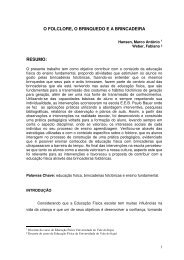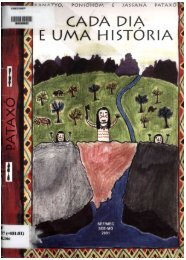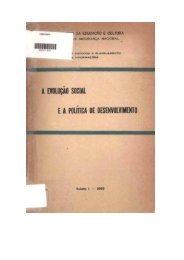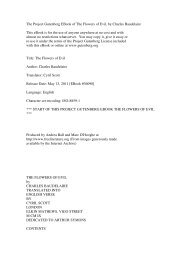A History of English Literature
A History of English Literature
A History of English Literature
Create successful ePaper yourself
Turn your PDF publications into a flip-book with our unique Google optimized e-Paper software.
forgetting his moral aim, Spenser fills the poem with moral observations,<br />
frequently setting them as guides at the beginning <strong>of</strong> the cantos.<br />
2. _The Allegory. Lack <strong>of</strong> Unity_. So complex and vast a plan could<br />
scarcely have been worked out by any human genius in a perfect and clear<br />
unity, and besides this, Spenser, with all his high endowments, was<br />
decidedly weak in constructive skill. The allegory, at the outset, even in<br />
Spenser's own statement, is confused and hazy. For beyond the primary moral<br />
interpretation, Spenser applies it in various secondary or parallel ways.<br />
In the widest sense, the entire struggle between the good and evil<br />
characters is to be taken as figuring forth the warfare both in the<br />
individual soul and in the world at large between Righteousness and Sin;<br />
and in somewhat narrower senses, between Protestantism and Catholicism, and<br />
between England and Spain. In some places, also, it represents other events<br />
and aspects <strong>of</strong> European politics. Many <strong>of</strong> the single persons <strong>of</strong> the story,<br />
entering into each <strong>of</strong> these overlapping interpretations, bear double or<br />
triple roles. Gloriana, the Fairy Queen, is abstractly Glory, but humanly<br />
she is Queen Elizabeth; and from other points <strong>of</strong> view Elizabeth is<br />
identified with several <strong>of</strong> the lesser heroines. So likewise the witch<br />
Duessa is both Papal Falsehood and Mary Queen <strong>of</strong> Scots; Prince Arthur both<br />
Magnificence and (with sorry inappropriateness) the Earl <strong>of</strong> Leicester; and<br />
others <strong>of</strong> the characters stand with more or less consistency for such<br />
actual persons as Philip II <strong>of</strong> Spain, Henry IV <strong>of</strong> France, and Spenser's<br />
chief, Lord Grey. In fact, in Renaissance spirit, and following Sidney's<br />
'Defense <strong>of</strong> Poesie,' Spenser attempts to harmonize history, philosophy,<br />
ethics, and politics, subordinating them all to the art <strong>of</strong> poetry. The plan<br />
is grand but impracticable, and except for the original moral<br />
interpretation, to which in the earlier books the incidents are skilfully<br />
adapted, it is fruitless as one reads to undertake to follow the<br />
allegories. Many readers are able, no doubt, merely to disregard them, but<br />
there are others, like Lowell, to whom the moral, 'when they come suddenly<br />
upon it, gives a shock <strong>of</strong> unpleasant surprise, as when in eating<br />
strawberries one's teeth encounter grit.'<br />
The same lack <strong>of</strong> unity pervades the external story. The first Book begins<br />
abruptly, in the middle; and for clearness' sake Spenser had been obliged<br />
to explain in his prefatory letter that the real commencement must be<br />
supposed to be a scene like those <strong>of</strong> Arthurian romance, at the court and<br />
annual feast <strong>of</strong> the Fairy Queen, where twelve adventures had been assigned<br />
to as many knights. Spenser strangely planned to narrate this beginning <strong>of</strong><br />
the whole in his final Book, but even if it had been properly placed at the<br />
outset it would have served only as a loose enveloping action for a series<br />
<strong>of</strong> stories essentially as distinct as those in Malory. More serious,<br />
perhaps, is the lack <strong>of</strong> unity within the single books. Spenser's genius was<br />
never for strongly condensed narrative, and following his Italian<br />
originals, though with less firmness, he wove his story as a tangled web <strong>of</strong><br />
intermingled adventures, with almost endless elaboration and digression.<br />
Incident after incident is broken <strong>of</strong>f and later resumed and episode after<br />
episode is introduced, until the reader almost abandons any effort to trace<br />
the main design. A part <strong>of</strong> the confusion is due to the mechanical plan.<br />
Each Book consists <strong>of</strong> twelve cantos (<strong>of</strong> from forty to ninety stanzas each)<br />
and <strong>of</strong>tentimes Spenser has difficulty in filling out the scheme. No one,<br />
certainly, can regret that he actually completed only a quarter <strong>of</strong> his<br />
projected work. In the six existing Books he has given almost exhaustive<br />
expression to a richly creative imagination, and additional prolongation<br />
would have done little but to repeat.<br />
Still further, the characteristic Renaissance lack <strong>of</strong> certainty as to the<br />
proper materials for poetry is sometimes responsible for a rudely















